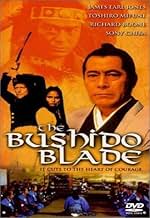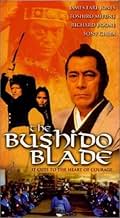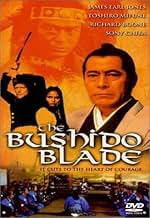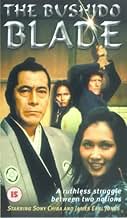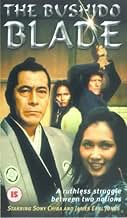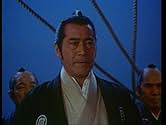IMDb-BEWERTUNG
5,3/10
468
IHRE BEWERTUNG
Füge eine Handlung in deiner Sprache hinzuA steel samurai blade that was to be given to the American ambassador by the Emperor of Japan is stolen. American sailors and Japanese samurai are sent to find it.A steel samurai blade that was to be given to the American ambassador by the Emperor of Japan is stolen. American sailors and Japanese samurai are sent to find it.A steel samurai blade that was to be given to the American ambassador by the Emperor of Japan is stolen. American sailors and Japanese samurai are sent to find it.
Mike Starr
- Bos'n Cave Johnson
- (as Michael Starr)
Timothy Patrick Murphy
- Midshipman Robin Burr
- (as Timothy Murphy)
Shin'ichi Chiba
- Prince Ido
- (as Sony Chiba)
Hitoshi Ômae
- Sumo
- (as Kin Omai)
Empfohlene Bewertungen
I read the premise on the back of the case and thought Bushido Blade would be a great movie. Granted, I knew movies about Japan made in years past could be somewhat contrived, but the description made it sound like a good adventure story in an interesting setting.
Unfortunately, this turned out to be less than that. While always entertaining, everything was a little gratuitous, a little forced, a little affected. The only particularly likable characters were Mifune's, Mako's and Chiba's, and the whole thing sort of just deflated as it went along.
Furthermore, I found myself laughing out loud at the particularly violent moments. Half of it was just at how intense they were, but a lot (if not most) of it was how unintentionally funny they were.
This leaves a lot to be desired. It's not bad by any means, but it has none of the magic that Mifune's other movies do.
Unfortunately, this turned out to be less than that. While always entertaining, everything was a little gratuitous, a little forced, a little affected. The only particularly likable characters were Mifune's, Mako's and Chiba's, and the whole thing sort of just deflated as it went along.
Furthermore, I found myself laughing out loud at the particularly violent moments. Half of it was just at how intense they were, but a lot (if not most) of it was how unintentionally funny they were.
This leaves a lot to be desired. It's not bad by any means, but it has none of the magic that Mifune's other movies do.
Way back in 1980, I saw "The Bushido Blade" as a late night premiere on CBS. Much younger then, I was fairly impressed with the romance and action and the film was fondly remembered over the decades.
25 years later, the film comes out in DVD and I had to get it.
Well...
My disappointment was palpable. Richard Boone gives a loud, obnoxious performance as Commodore Matthew Perry, top billed James Earl Jones, while in fine voice and shape, only appears for about 2 minutes of screen time. The rugged Frank Converse comes off fairly well, but I can't understand why a Japanese actress was not cast as Tomoe instead of Laura Gemser. Sonny Chiba and Mako make good impressions, but something's not right when Mayumi Asano, playing Yuki, gives the best performance in the film. And this, with virtually no dialog. But, perhaps, that explains it right there.
Poorly written by William Overgard, a Rankin-Bass in-house hack, the story, beginning with an offensive minstrel show, is about the search by American sailors for a stolen ceremonial samurai sword, meant as a gift for the President of the United States in 1854 Japan. The three Americans are aided in their search by noble samurai Chiba and half-caste warrior Gemser. What bothers me most is the lack of any texture in the story. Most scenes take place against utilitarian sets with no detail. The countryside, where most of what passes as action takes place, is flatly filmed. Worst of all, none of the local Japanese have any significant dialog, and surprisingly, have no involvement in the story, but, act only as background color for the three or four major characters. Very strange. I think there are less than 10 speaking roles and half of those are of the "Yes, Sir. No, Sir" variety from extras.
After some disappointing samurai battle action over the sword against a lord and his poorly trained army of warriors...it just ends. You might be surprised by the suddenness of the fade out, but, that's all there is. I understand there is an alternate version running about 10 minutes longer, but, besides an extended ending, I can't imagine what might be missing or added to improve things. In retrospect, viewing the film after so many years brought back certain story reservations I had even as a youngster. Plot holes abound and the final fate of the sword and it's pursuers is not ironic as intended, but just leaves a bad taste in your mouth.
25 years later, the film comes out in DVD and I had to get it.
Well...
My disappointment was palpable. Richard Boone gives a loud, obnoxious performance as Commodore Matthew Perry, top billed James Earl Jones, while in fine voice and shape, only appears for about 2 minutes of screen time. The rugged Frank Converse comes off fairly well, but I can't understand why a Japanese actress was not cast as Tomoe instead of Laura Gemser. Sonny Chiba and Mako make good impressions, but something's not right when Mayumi Asano, playing Yuki, gives the best performance in the film. And this, with virtually no dialog. But, perhaps, that explains it right there.
Poorly written by William Overgard, a Rankin-Bass in-house hack, the story, beginning with an offensive minstrel show, is about the search by American sailors for a stolen ceremonial samurai sword, meant as a gift for the President of the United States in 1854 Japan. The three Americans are aided in their search by noble samurai Chiba and half-caste warrior Gemser. What bothers me most is the lack of any texture in the story. Most scenes take place against utilitarian sets with no detail. The countryside, where most of what passes as action takes place, is flatly filmed. Worst of all, none of the local Japanese have any significant dialog, and surprisingly, have no involvement in the story, but, act only as background color for the three or four major characters. Very strange. I think there are less than 10 speaking roles and half of those are of the "Yes, Sir. No, Sir" variety from extras.
After some disappointing samurai battle action over the sword against a lord and his poorly trained army of warriors...it just ends. You might be surprised by the suddenness of the fade out, but, that's all there is. I understand there is an alternate version running about 10 minutes longer, but, besides an extended ending, I can't imagine what might be missing or added to improve things. In retrospect, viewing the film after so many years brought back certain story reservations I had even as a youngster. Plot holes abound and the final fate of the sword and it's pursuers is not ironic as intended, but just leaves a bad taste in your mouth.
"A swashbuckling Samurai saga that beats SHOGUN!" - Star Bulletin
Now, I bought a copy of this motion picture on video cassette that was released by Thorn-EMI Video, which means that the violence, beheadings, blood, and nudity are all intact as opposed to edited in the TV broadcast version.
The reason why I purchased it: I needed a test tape for VCR repair. For one dollar, you get an old tape where you wouldn't care if the machine decided to eat it!
Anyways, since I bought the tape and have also seen Shogun before, I figured I would give it a whurl. I have watched this movie and I'm glad I only spent one dollar on it!
While the premise of the story is certainly interesting enough, the low budget and TV-like production values doesn't do the premise any justice at all.
The acting feels badly forced at many points, which is also coupled with some rather claustrophobic cinematography, nervous direction, and snapshot editing. (It felt like I was watching a TV show that seemed to almost feel like "Hawaii Five-O" with all the pointless and quick zoom-ins to objects in the frame.)
The pacing felt somewhat uneven, perhaps to where it was trying to rush the story forward to reach the end sooner. This might explain the 92 minutes runtime on something that might have required up to 150 minutes to properly play in order to account for character relation to each other and their settings. In contrast, Paramount wisely produced Shogun as a television miniseries, as the original novel could simply not be condensed to even a four hour epic without losing too much. (Although, the re-editing of the miniseries with only a small helping of new footage in an attempt to make a motion picture out of Shogun was a very bad idea.)
There didn't seem to be very good interplay between the characters. The relationships that you may see develop in this picture tend to develop rather quickly and, therefore, unrealistically. The characters also seem somewhat simple and, in many ways, unbelievable. In concert with the atrocious acting, it made watching the characters about as appealing as watching a bad sci-fi movie without MST3K. In contrast, Shogun had characters that developed intricate interplay over a long period of time. They had shown themselves as complex individuals and continued to develop in the settings and with the other characters throughout the story.
Also, the one thing that caught me totally off-guard was the production company: Rankin-Bass.
Now, Rankin-Bass is a production company that is primarily responsible for children's programming. They had produced the animated version of "The Hobbit," "The Last Unicorn (1980s, ITC)," and "The King and I (1999, Warner Bros)," as well as producing various Christmas specials in the 1960s and 1970s like "Frosty, the Snowman" (Need to get to the north pole before melting), "Rudolph the Red Nosed Reindeer" (I don't want to wear a lump of coal on my nose!), "Little Drummer Boy," and "T'was the night before Christmas" (You know, the one with the singing clock to make Santa forgive a city for a letter written by some mouse who used "long words."). To those familiar with the 1980s, Rankin-Bass was also responsible for "Thundercats" and "Silverhawks."
Now, this did give a reason why the movie sucked as a whole: a production company with experience only with children's entertainment cannot hope to produce an R rated picture without creative difficulty.
Now, even though this film was co-produced with a British firm: Trident Films, the producer was Arthur Rankin Jr. himself. Jules Bass apparently did not have any involvement with this production.
Watch out for a cameo by James Earl Jones. Mako, Toshiro Mufune (who played in Shogun as well), and Sonny Chiba are other well regarded actors who starred in this movie.
If anything, try it for a rental and watch for yourself. This is assuming your local video store even has this movie for rent.
This movie does deserve some credit for at least trying to maintain a standard, although I would only give it one and half stars.
I might have given it worse, but watching REAL garbage like "Space Mutiny" and "Strategic Command" does make "Bushido Blade" and even "Xanadu" look decent. - Reinhart
Now, I bought a copy of this motion picture on video cassette that was released by Thorn-EMI Video, which means that the violence, beheadings, blood, and nudity are all intact as opposed to edited in the TV broadcast version.
The reason why I purchased it: I needed a test tape for VCR repair. For one dollar, you get an old tape where you wouldn't care if the machine decided to eat it!
Anyways, since I bought the tape and have also seen Shogun before, I figured I would give it a whurl. I have watched this movie and I'm glad I only spent one dollar on it!
While the premise of the story is certainly interesting enough, the low budget and TV-like production values doesn't do the premise any justice at all.
The acting feels badly forced at many points, which is also coupled with some rather claustrophobic cinematography, nervous direction, and snapshot editing. (It felt like I was watching a TV show that seemed to almost feel like "Hawaii Five-O" with all the pointless and quick zoom-ins to objects in the frame.)
The pacing felt somewhat uneven, perhaps to where it was trying to rush the story forward to reach the end sooner. This might explain the 92 minutes runtime on something that might have required up to 150 minutes to properly play in order to account for character relation to each other and their settings. In contrast, Paramount wisely produced Shogun as a television miniseries, as the original novel could simply not be condensed to even a four hour epic without losing too much. (Although, the re-editing of the miniseries with only a small helping of new footage in an attempt to make a motion picture out of Shogun was a very bad idea.)
There didn't seem to be very good interplay between the characters. The relationships that you may see develop in this picture tend to develop rather quickly and, therefore, unrealistically. The characters also seem somewhat simple and, in many ways, unbelievable. In concert with the atrocious acting, it made watching the characters about as appealing as watching a bad sci-fi movie without MST3K. In contrast, Shogun had characters that developed intricate interplay over a long period of time. They had shown themselves as complex individuals and continued to develop in the settings and with the other characters throughout the story.
Also, the one thing that caught me totally off-guard was the production company: Rankin-Bass.
Now, Rankin-Bass is a production company that is primarily responsible for children's programming. They had produced the animated version of "The Hobbit," "The Last Unicorn (1980s, ITC)," and "The King and I (1999, Warner Bros)," as well as producing various Christmas specials in the 1960s and 1970s like "Frosty, the Snowman" (Need to get to the north pole before melting), "Rudolph the Red Nosed Reindeer" (I don't want to wear a lump of coal on my nose!), "Little Drummer Boy," and "T'was the night before Christmas" (You know, the one with the singing clock to make Santa forgive a city for a letter written by some mouse who used "long words."). To those familiar with the 1980s, Rankin-Bass was also responsible for "Thundercats" and "Silverhawks."
Now, this did give a reason why the movie sucked as a whole: a production company with experience only with children's entertainment cannot hope to produce an R rated picture without creative difficulty.
Now, even though this film was co-produced with a British firm: Trident Films, the producer was Arthur Rankin Jr. himself. Jules Bass apparently did not have any involvement with this production.
Watch out for a cameo by James Earl Jones. Mako, Toshiro Mufune (who played in Shogun as well), and Sonny Chiba are other well regarded actors who starred in this movie.
If anything, try it for a rental and watch for yourself. This is assuming your local video store even has this movie for rent.
This movie does deserve some credit for at least trying to maintain a standard, although I would only give it one and half stars.
I might have given it worse, but watching REAL garbage like "Space Mutiny" and "Strategic Command" does make "Bushido Blade" and even "Xanadu" look decent. - Reinhart
Great cast. Too bad the rest of it couldn't match up.
Richard Boone plays a growling Cmmdr. Perry in his last role. And REALLY chews it up.
Frank (Coronet Blue) Converse (The real star) attempts to be an action hero. Not enough action though. And He's a little wooden.
Any Asian actor with a name dropped by for a cameo. Seeing the late, great Toshiro Mifune reprise most of his previous samurai roles was nice. And Sonny Chiba's warrior cliché is something I never get tired of. Then there's Mako as the cliché' wise man.
Laura (GODDESS) Gemser showing up made it worth the price of a rental. (To me anyway. She is GORGEOUS.) Seeing a young Mike Starr was kind of cool. He was obviously meant to be comedy relief.
James Earl Jones role should have been larger. Is this film still cut? An adventure story about finding a stolen sword could have and should have been a lot better.
And that minstrel show on the ship might anger a few people...even if it is based on facts of the times.
Not a waste...not unmissable either.
Richard Boone plays a growling Cmmdr. Perry in his last role. And REALLY chews it up.
Frank (Coronet Blue) Converse (The real star) attempts to be an action hero. Not enough action though. And He's a little wooden.
Any Asian actor with a name dropped by for a cameo. Seeing the late, great Toshiro Mifune reprise most of his previous samurai roles was nice. And Sonny Chiba's warrior cliché is something I never get tired of. Then there's Mako as the cliché' wise man.
Laura (GODDESS) Gemser showing up made it worth the price of a rental. (To me anyway. She is GORGEOUS.) Seeing a young Mike Starr was kind of cool. He was obviously meant to be comedy relief.
James Earl Jones role should have been larger. Is this film still cut? An adventure story about finding a stolen sword could have and should have been a lot better.
And that minstrel show on the ship might anger a few people...even if it is based on facts of the times.
Not a waste...not unmissable either.
Bushido Blade is a film that kind of got lost with all the hoopla surrounding the Shogun TV mini-series. Commodore Perry's opening of Japan deserved a better treatment than what it got here.
No reflection on the cast, they certainly try hard enough. And the making of the film is a service of sorts because America is woefully ignorant about Japan other than knowing that they were our opponents in World War II.
Making his farewell appearance on the screen is Richard Boone as the crusty Commodore Matthew Calbraith Perry. From what little I know of Perry, Boone seems to have captured him very well. Perry was the younger brother of Oliver Hazard Perry who was the commander of the Great Lakes Navy that beat the British and kept them from invading us through Canada. Younger brother Cal (family and friends used Perry's middle name when addressing him)served in the United States Navy for over 30 years and the opening of Japan was the capstone of a great career.
Bushido Blade is a fictional sideline to the true events surrounding the treaty Perry signed with the Shogun. There was a faction in Japan who wanted to keep the country's isolationist policy going and were quite willing to do anything in that endeavor. They steal a ceremonial samurai sword that is to be presented to President Franklin Pierce by Perry. As this is a question of honor, the Japanese balk at signing the treaty at the last minute.
The Japanese insist on themselves recovering the sword, but Perry unofficially sends Marine Captain Frank Converse, Boatswain Mike Starr, and young Naval Midshipman Timothy Patrick Murphy on his own mission. The three get split up during an attack. The bulk of the film is the separate experiences of all three.
Frank Converse is a fine actor, but I couldn't quite believe him as an instant Samurai. When he has to battle the champion Samurai he gets a bit of help to say the least. Skill with a Samurai sword is not something one learns on the job or on the fly and by rights he should never have survived.
Young Timothy Patrick Murphy cuts a fine romantic figure as his odyssey includes a small romantic interlude with a young Japanese girl who is intrigued by this occidental who speaks her language. Murphy reminded me just a bit of Tyrone Power in Son of Fury. It was sad indeed that he died so young of AIDS, he had a great career ahead of him.
Such fine Japanese players as Toshiro Mifune, Tetsuro Tamba, and Mako fill their roles well. I very much enjoyed James Earl Jones who played a whaling harpooner who was a prisoner. Before the treaty was signed with Japan, sailors from the west who had the misfortune to be shipwrecked in Japan could expect never to see home again.
The Bushido Blade is an average film about a key incident in both American and Japanese history. It could have used a lot more of everything, direction, production values, editing. But the players did their best with it.
A good triple feature one day might be watching The Barbarian and the Geisha even with a woefully miscast John Wayne, The Bushido Blade, and the best film on 19th century Japan after the opening, The Last Samurai with Tom Cruise. It's a chance to see the Japanese as more than our enemies in World War II or having their city's destroyed by some prehistoric beast.
No reflection on the cast, they certainly try hard enough. And the making of the film is a service of sorts because America is woefully ignorant about Japan other than knowing that they were our opponents in World War II.
Making his farewell appearance on the screen is Richard Boone as the crusty Commodore Matthew Calbraith Perry. From what little I know of Perry, Boone seems to have captured him very well. Perry was the younger brother of Oliver Hazard Perry who was the commander of the Great Lakes Navy that beat the British and kept them from invading us through Canada. Younger brother Cal (family and friends used Perry's middle name when addressing him)served in the United States Navy for over 30 years and the opening of Japan was the capstone of a great career.
Bushido Blade is a fictional sideline to the true events surrounding the treaty Perry signed with the Shogun. There was a faction in Japan who wanted to keep the country's isolationist policy going and were quite willing to do anything in that endeavor. They steal a ceremonial samurai sword that is to be presented to President Franklin Pierce by Perry. As this is a question of honor, the Japanese balk at signing the treaty at the last minute.
The Japanese insist on themselves recovering the sword, but Perry unofficially sends Marine Captain Frank Converse, Boatswain Mike Starr, and young Naval Midshipman Timothy Patrick Murphy on his own mission. The three get split up during an attack. The bulk of the film is the separate experiences of all three.
Frank Converse is a fine actor, but I couldn't quite believe him as an instant Samurai. When he has to battle the champion Samurai he gets a bit of help to say the least. Skill with a Samurai sword is not something one learns on the job or on the fly and by rights he should never have survived.
Young Timothy Patrick Murphy cuts a fine romantic figure as his odyssey includes a small romantic interlude with a young Japanese girl who is intrigued by this occidental who speaks her language. Murphy reminded me just a bit of Tyrone Power in Son of Fury. It was sad indeed that he died so young of AIDS, he had a great career ahead of him.
Such fine Japanese players as Toshiro Mifune, Tetsuro Tamba, and Mako fill their roles well. I very much enjoyed James Earl Jones who played a whaling harpooner who was a prisoner. Before the treaty was signed with Japan, sailors from the west who had the misfortune to be shipwrecked in Japan could expect never to see home again.
The Bushido Blade is an average film about a key incident in both American and Japanese history. It could have used a lot more of everything, direction, production values, editing. But the players did their best with it.
A good triple feature one day might be watching The Barbarian and the Geisha even with a woefully miscast John Wayne, The Bushido Blade, and the best film on 19th century Japan after the opening, The Last Samurai with Tom Cruise. It's a chance to see the Japanese as more than our enemies in World War II or having their city's destroyed by some prehistoric beast.
Wusstest du schon
- WissenswertesAlthough this film was derided as an attempt to copy the hit TV mini-series Shogun (1980), it was actually made in 1978, before Shogun (1980), though it wasn't released until after that series had aired.
- Crazy CreditsThe producers gratefully acknowledge the cooperation of Toho Studios staff and personnel in the production of this picture.
- Alternative VersionenFirst shown in USA in a 92-minute version on cable television, prior to a theatrical release in the USA of the complete 104-minute version, this retitled "The Bloody Bushido Blade."
- VerbindungenFeatured in Vintage Video: 0249 The Bushido Blade (1981) (2021)
Top-Auswahl
Melde dich zum Bewerten an und greife auf die Watchlist für personalisierte Empfehlungen zu.
- How long is The Bushido Blade?Powered by Alexa
Details
- Erscheinungsdatum
- Herkunftsländer
- Sprachen
- Auch bekannt als
- The Bloody Bushido Blade
- Drehorte
- Produktionsfirmen
- Weitere beteiligte Unternehmen bei IMDbPro anzeigen
Zu dieser Seite beitragen
Bearbeitung vorschlagen oder fehlenden Inhalt hinzufügen



